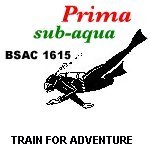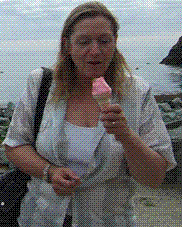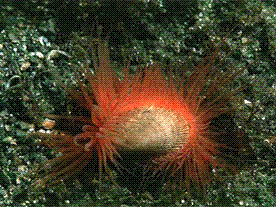
Issue 6 May 2007
Off-Gassing...
(Web Version)
Welcome to the sixth issue of our newsletter.
The Diving Year as well and truly begun and the weather is perfect for it.
Profile:- Lin Noakes
Challaborough
5th - 7th May
__________
Isle of Wight
26th - 28th May
___________
It was 1989, Fay had joined a snorkelling club and needed a buddy. Because snorkelling clubs (then run by the NSA) had an upper age limit of 16, the only option was for me to undertake the snorkel training, which preceded aqualung training in those days. Prima had been running for about 6 months when I went along for the first time. Instead of a snorkel I was given a try-dive and loved it. I could barely swim and couldn't tread water, so it took a while to improve enough to pass the dreaded water fitness test. Al and Sue were recruited also and we all trained together.
 My favourite place to dive is West Scotland. The
Clubs first trip to the Sound of Mull was in 1999 and we have been back
every year since. Lately combining the wrecks of Mull with the scenic
dives and prolific seafood of Skye. I've also dived many times in the
Red Sea and the Med as well as most of the popular British coastal
sites.
My favourite place to dive is West Scotland. The
Clubs first trip to the Sound of Mull was in 1999 and we have been back
every year since. Lately combining the wrecks of Mull with the scenic
dives and prolific seafood of Skye. I've also dived many times in the
Red Sea and the Med as well as most of the popular British coastal
sites.
The best thing about diving for me is the sheer variety - wrecks, reefs, caves and caverns, diving off hard boats and ribs, drift dives, training dives and just getting away for the weekend. Oh and the other best thing is the unexpected, like swimming with a basking shark in Skye or being surrounded by dolphins off Puffin Island, last Sunday.
Advice: Dive in the sea as often as you can because there is always the chance of seeing something out of the ordinary.
Cockups: A long time ago I got the brass ass for returning to the wrong boat in the Red Sea (I have a really good excuse). More recently I've tried diving without fins (not to be recommended)
Special note from the Webmaster: We won't say anything about Vintage Single Malt & Coffee or Marker bouys & SMBs
Seasearch - Course 3rd March 2007
10 litre Cylinder. In test
£50 contact: Richard Mace
0121 232 6007
If you have any items for sale please let us know.
Seasearch is a project for recreational divers who want to do their bit for the marine environment by collecting information about the marine habitats, plants and animals that only divers see. We can carry out Seasearch dives with our club, buddy or organised Seasearch weekends. The initial part of the Seasearch course was not as I expected it to be, the lecturer dealt more with how to record what you observed rather than instructing on how to identify the items we see under water. This does not mean that I did not find the lecturer interesting or instructive, far from it, it was both. We were taught how to recognise the main underwater habitat types and a small number of species, and to record these on the straight forward Seasearch Observation Forms.Check:-www.seasearch.org.uk
Wreck of the Month. The Jebba
Editors Corner
Thank you to everyone who has contributed to this months issue, and
apologies for any mistakes.
Any further articles for next months edition would be appreciated, (any gossip, scandals, etc that’s printable) so let us know by 20th May.
Hope you enjoyed this issue.
The Jebba
In the early hours of 18 March 1907 the liner Jebba overshot the Eddystone in dense fog and ran aground under the steep cliffs at Whitchurch, just a few yards away from Bolt Tail.
Today the remains of the Jebba lie in less than thirty feet, exactly where she hit, which is as close into the rocks as you dare take your boat. As you look at the shore from the sea, her stern lies to your left and her bows to the right. The bottom consists of rock and sand, and in the summer there is quite a bit of kelp. The wreckage lies all around you and so does the brass and copper. Most of it is well crudded into the wreck but the odd valve is still available if you look hard enough for it. Where the stern is, two rocks break the surface, and in between these lies the rudder, still more or less complete. As you fin from the stern along the ribs and decking of the Jebba, you come to a stretch of sand upon which lie two boilers, one stuck up on it's end. Further out from these are rocky gullies with all sorts of bits of wreckage, broken pottery, and pieces of brass nametags crudded into the rock. On a sunny day, the diving and the spectacular scenery should keep you amused for hours.
Gaping Fire Shells
 It is a
bi-valve, so belongs to the same family of animals as mussels,
oysters, and scallops. It is called the gaping file shell because
when viewed from the side, the two halves of the shell have a gaping
hole between them near the “hinge”.
It is a
bi-valve, so belongs to the same family of animals as mussels,
oysters, and scallops. It is called the gaping file shell because
when viewed from the side, the two halves of the shell have a gaping
hole between them near the “hinge”.The shell is approximately 25mm long and has about 50 ridges or ribs running the length of the shell. The shell itself is white, but gets dirty and discoloured with age. The most distinctive parts of this animal, and how it got the name flame-shell, are the orange, filamentous tentacles around the edge of the shell. When these are seen under-water it looks somewhat like an erupting volcano
The species can swim, when disturbed. This is done by using jets of water expelled by 'clapping' its shells together and a rowing motion of its tentacles.
They are found from the lower shore, down to a depth of 100m on coarse sand, gravel, broken shells and stones. It may create and occupy 'nests' of byssus threads among rubble, under stones or in the holdfast of other animals. Byssus threads are what mussels use to anchor themselves to rocks. When they are abundant, the 'nests' can merge to form a carpet or reef over shell-sand, this can provide a foothold for kelps
Records of distribution around the UK state it is found off of Plymouth Sound, Stockholm, the southern Isle of Man, western coasts and lochs of Scotland, and Mulroy Bay, Northern Ireland.
Distinctive features
Mantle edge bears numerous, conspicuous red and orange contractile tentacles.
Shell, oval in outline, usually white and bearing about 50 radiating ribs.
Shell gapes prominently on each side.
Builds byssus nests.